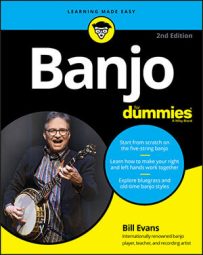These days, bluegrass banjo isn't limited to the dazzling roll-based approach created by Earl Scruggs in the 1940s and 1950s. Bluegrass banjo today also includes the melodic innovations of Bill Keith and Bobby Thompson (from the 1960s) along with the single-string techniques blazed by Eddie Adcock and Don Reno (in the 1950s and '60s), which have been taken to new heights of virtuosity more recently by modern players like Béla Fleck and Noam Pikelny.
Just about any kind of music can be played on the banjo today using these techniques, and you can mix all three approaches to make great-sounding banjo music. Using the instrumental favorite "Old Joe Clark" as an example, check out these different ways of playing.
Scruggs style
Scruggs-style banjo is a roll-based approach where you use a different right-hand finger (either the thumb, index, or middle finger) consecutively for each eighth note you strike. Most of the time, you also move to a different string with each note you play. Not every note in Scruggs style is considered a primary melody note, so it's your job to make those notes stand out by playing them with a bit more volume.
Consider this arrangement of the first half of "Old Joe Clark" using Scruggs techniques:
![[Credit: Tab courtesy of Bill Evans]](https://www.dummies.com/wp-content/uploads/408315.image0.jpg)
Melodic style
With melodic style banjo, you use a different right-hand finger to play consecutive notes, just like you do in Scruggs-style playing. However, melodic banjo allows you to play all kinds of scales on the instrument, which lets you group melody notes closer together than you can using Scruggs techniques.
The challenge with melodic-style banjo is that a higher scale note is often found on a lower string, resulting in some unusual moves in both the fretting and picking hands. Melodic arrangements can also be a bit tougher to memorize, but this style is perfect for capturing fast-moving, complex melodies using three-finger picking techniques.
Check out the first part of "Old Joe Clark" in melodic style:
![[Credit: Tab courtesy of Bill Evans]](https://www.dummies.com/wp-content/uploads/408316.image1.jpg)
Single-string style
Single-string technique offers a different way to play scales and scale-based melodies on the banjo. Instead of playing consecutive scale notes on different strings as in melodic style, single-string banjo utilizes a right-hand technique of playing scales on the same string — the single string — for a few notes at a time before moving to another string. The left-hand fretting moves are also different because you find the notes on the fingerboard in other places than in Scruggs or melodic style.
Single-string picking technique is similar in many ways to playing lead guitar with a flatpick. Instead of the flatpick moving up and down to play notes on the same string, on the banjo you alternate your right-hand thumb and index fingers or use roll pattern combinations of your thumb, index, and middle fingers to play melodies on single strings.
Try out this single-string version of the first section of "Old Joe Clark" and note that left-hand fingering suggestions are indicated above the tab staff:
![[Credit: Tab courtesy of Bill Evans]](https://www.dummies.com/wp-content/uploads/408317.image2.jpg)
It's amazing how one tune can be played so many different ways, isn't it? That's what makes playing the banjo so much fun — you can always add a new technique or lick to the most familiar song. When you master all three techniques, you'll be able to play everything from bluegrass to jazz and classical music on the five-string banjo.

